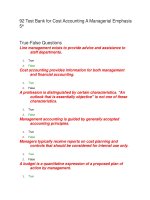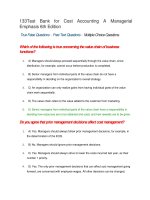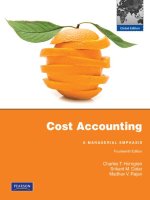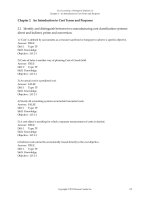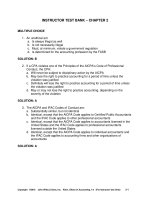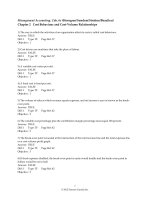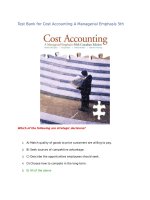Cost accounting a managerial emphasis sixth canadian edition 6th edition horngren test bank
Bạn đang xem bản rút gọn của tài liệu. Xem và tải ngay bản đầy đủ của tài liệu tại đây (491.63 KB, 62 trang )
Cost Accounting: A Managerial Emphasis, 6e
Chapter 2 – An Introduction to Cost Terms and Purposes
Chapter 2 An Introduction to Cost Terms and Purposes
2.1 Identify and distinguish between two manufacturing cost classification systems:
direct and indirect, prime and conversion.
1) "Cost" is defined by accountants as a resource sacrificed or foregone to achieve a specific objective.
Answer: TRUE
Diff: 1
Type: TF
Skill: Knowledge
Objective: LO 2-1
2) Costs of Sales is another way of phrasing Cost of Goods Sold.
Answer: TRUE
Diff: 2
Type: TF
Skill: Knowledge
Objective: LO 2-1
3) An actual cost is a predicted cost.
Answer: FALSE
Diff: 1
Type: TF
Skill: Knowledge
Objective: LO 2-1
4) Nearly all accounting systems accumulate forecasted costs.
Answer: FALSE
Diff: 1
Type: TF
Skill: Knowledge
Objective: LO 2-1
5) A cost object is anything for which a separate measurement of costs is desired.
Answer: TRUE
Diff: 1
Type: TF
Skill: Knowledge
Objective: LO 2-1
6) Indirect costs cannot be economically traced directly to the cost objective.
Answer: TRUE
Diff: 1
Type: TF
Skill: Knowledge
Objective: LO 2-1
Copyright © 2013 Pearson Canada Inc.
2-1
Cost Accounting: A Managerial Emphasis, 6e
Chapter 2 – An Introduction to Cost Terms and Purposes
7) Delivery charges are typically considered to be an indirect cost because it cannot be traced to each
customer.
Answer: FALSE
Diff: 2
Type: TF
Skill: Comprehension
Objective: LO 2-1
8) A cost is classified as a direct or indirect cost based on the applicable cost object.
Answer: TRUE
Diff: 1
Type: TF
Skill: Knowledge
Objective: LO 2-1
9) Cost tracing assigns indirect costs to the chosen cost object.
Answer: FALSE
Diff: 1
Type: TF
Skill: Knowledge
Objective: LO 2-1
10) Factors affecting direct/indirect cost classifications are the materiality of the cost in question, the
information-gathering technology used, and the operations.
Answer: TRUE
Diff: 1
Type: TF
Skill: Knowledge
Objective: LO 2-1
11) A firm's strategy and mission are usually the same.
Answer: FALSE
Diff: 1
Type: TF
Skill: Knowledge
Objective: LO 2-1
12) Governance refers to a company's relationship with all levels of government.
Answer: FALSE
Diff: 1
Type: TF
Skill: Knowledge
Objective: LO 2-1
13) A value proposition is a distinct benefit for which customers will pay.
Answer: TRUE
Diff: 1
Type: TF
Skill: Knowledge
Objective: LO 2-1
Copyright © 2013 Pearson Canada Inc.
2-2
Cost Accounting: A Managerial Emphasis, 6e
Chapter 2 – An Introduction to Cost Terms and Purposes
14) Rent for the building that contains the manufacturing and engineering departments can all be charged
as manufacturing overhead costs.
Answer: FALSE
Diff: 2
Type: TF
Skill: Comprehension
Objective: LO 2-1
15) The plant supervisor's salary is a direct labour cost.
Answer: FALSE
Diff: 2
Type: TF
Skill: Knowledge
Objective: LO 2-1
16) Inventoriable costs are reported as an asset when incurred and expensed on the income statement
when the product is sold.
Answer: TRUE
Diff: 2
Type: TF
Skill: Knowledge
Objective: LO 2-1
17) Period costs are never included as part of inventory.
Answer: TRUE
Diff: 1
Type: TF
Skill: Knowledge
Objective: LO 2-1
18) Conversion costs include all direct manufacturing costs.
Answer: FALSE
Diff: 1
Type: TF
Skill: Knowledge
Objective: LO 2-1
19) Overtime premium consists of wages paid to all workers in excess of their straight-time wage rates.
Answer: TRUE
Diff: 1
Type: TF
Skill: Knowledge
Objective: LO 2-1
20) Prime costs consist of direct and indirect manufacturing labour.
Answer: FALSE
Diff: 1
Type: TF
Skill: Knowledge
Objective: LO 2-1
Copyright © 2013 Pearson Canada Inc.
2-3
Cost Accounting: A Managerial Emphasis, 6e
Chapter 2 – An Introduction to Cost Terms and Purposes
21) Conversion costs are all manufacturing costs other than direct materials.
Answer: TRUE
Diff: 1
Type: TF
Skill: Knowledge
Objective: LO 2-1
22) Overtime premium is always a component of direct labour.
Answer: FALSE
Diff: 1
Type: TF
Skill: Knowledge
Objective: LO 2-1
23) Products, services, departments, and customers may be cost objects.
Answer: TRUE
Diff: 1
Type: TF
Skill: Knowledge
Objective: LO 2-1
24) Costs are accounted for in two basic stages: assignment followed by accumulation.
Answer: FALSE
Explanation: Costs are accounted for in two basic stages: accumulation followed by assignment.
Diff: 1
Type: TF
Skill: Comprehension
Objective: LO 2-1
25) A cost object is always either a product or a service.
Answer: FALSE
Explanation: A cost object could be anything management wishes to determine the cost of, for example, a
department.
Diff: 2
Type: TF
Skill: Knowledge
Objective: LO 2-1
26) Assigning direct costs poses more problems than assigning indirect costs.
Answer: FALSE
Explanation: Tracing direct costs is quite straightforward, whereas assigning indirect costs to a number
of different cost objects can be very challenging.
Diff: 2
Type: TF
Skill: Comprehension
Objective: LO 2-1
27) A department could be considered a cost object.
Answer: TRUE
Diff: 2
Type: TF
Skill: Knowledge
Objective: LO 2-1
Copyright © 2013 Pearson Canada Inc.
2-4
Cost Accounting: A Managerial Emphasis, 6e
Chapter 2 – An Introduction to Cost Terms and Purposes
28) Improvements in information-gathering technologies are making it possible to trace more costs as
direct.
Answer: TRUE
Diff: 2
Type: TF
Skill: Comprehension
Objective: LO 2-1
29) Anything for which a separate measurement of costs is desired is known as
A) a cost item.
B) a cost object.
C) a fixed cost item.
D) a variable cost object.
E) a cost driver.
Answer: B
Diff: 1
Type: MC
Skill: Knowledge
Objective: LO 2-1
30) Which of the following is a cost object?
A) direct materials
B) customers
C) conversion costs
D) cost assignments
E) indirect labour
Answer: B
Diff: 2
Type: MC
Skill: Knowledge
Objective: LO 2-1
31) Which of the following is an indirect production cost?
A) materials placed into production
B) calibrating factory equipment
C) labour placed into production
D) cost of shipping a product to the customer
E) advertising
Answer: B
Diff: 1
Type: MC
Skill: Knowledge
Objective: LO 2-1
Copyright © 2013 Pearson Canada Inc.
2-5
Cost Accounting: A Managerial Emphasis, 6e
Chapter 2 – An Introduction to Cost Terms and Purposes
32) Actual costs are defined as
A) costs incurred.
B) direct costs.
C) indirect costs.
D) predicted costs.
E) sunk costs.
Answer: A
Diff: 1
Type: MC
Skill: Knowledge
Objective: LO 2-1
33) Whether a company traces costs directly to an output unit or not depends upon
A) the materiality of the contribution a cost makes to the total cost per output unit.
B) the amount of similar costs in the cost assignment.
C) the effect of cost tracing on overhead.
D) the employment of cost management.
E) the amount of customer satisfaction.
Answer: A
Diff: 1
Type: MC
Skill: Knowledge
Objective: LO 2-1
34) Which one of the following items is typically an example of an indirect cost of a cost object?
A) courier charges for shipment delivery
B) manufacturing plant electricity
C) direct manufacturing labour
D) wood used for furniture manufacture
E) refundable sales tax on direct materials
Answer: B
Diff: 2
Type: MC
Skill: Comprehension
Objective: LO 2-1
35) Prime costs can include
A) conversion costs.
B) direct material costs.
C) indirect manufacturing labour.
D) machine set up costs.
E) advertizing costs.
Answer: B
Diff: 2
Type: MC
Skill: Knowledge
Objective: LO 2-1
Copyright © 2013 Pearson Canada Inc.
2-6
Cost Accounting: A Managerial Emphasis, 6e
Chapter 2 – An Introduction to Cost Terms and Purposes
36) Which one of the following examples could be classified as a direct cost?
A) The costs of an entire factory's electricity related to a product; the product line is the cost object.
B) The printing costs incurred for payroll cheque processing; the payroll cheque processing is the cost
object.
C) The salary of a maintenance supervisor in the manufacturing plant; Product A is the cost object.
D) The costs incurred for electricity in the office; the accounting office is the cost object.
E) The cost of advertising the products.
Answer: B
Diff: 2
Type: MC
Skill: Comprehension
Objective: LO 2-1
37) The determination of a cost as being either direct or indirect depends upon
A) the accounting system.
B) the allocation system.
C) the cost tracing system.
D) only the cost object chosen to determine its individual costs.
E) the choice of the cost object, and the materiality of the cost in question.
Answer: E
Diff: 2
Type: MC
Skill: Knowledge
Objective: LO 2-1
38) Cost assignment is
A) always arbitrary.
B) linking actual costs to cost objects.
C) the same as cost accumulation.
D) finding the difference between budgeted and actual costs.
E) the same as cost conversion.
Answer: B
Diff: 2
Type: MC
Skill: Knowledge
Objective: LO 2-1
39) Wages paid to machine operators on an assembly line are an example of which type of cost?
A) direct manufacturing labour costs
B) direct manufacturing overhead costs
C) direct materials costs
D) indirect manufacturing overhead costs
E) indirect material costs
Answer: A
Diff: 2
Type: MC
Skill: Comprehension
Objective: LO 2-1
Copyright © 2013 Pearson Canada Inc.
2-7
Cost Accounting: A Managerial Emphasis, 6e
Chapter 2 – An Introduction to Cost Terms and Purposes
40) Which of the following is true concerning prime costs?
A) Prime costs are direct manufacturing costs.
B) They include indirect direct manufacturing labour.
C) They equal the sum of direct manufacturing costs plus conversion costs.
D) They equal the sum of fixed manufacturing costs plus conversion costs.
E) They are indirect manufacturing costs.
Answer: A
Diff: 1
Type: MC
Skill: Knowledge
Objective: LO 2-1
41) Which statement about conversion costs is correct, using the three-part classification of costs?
A) They include only direct manufacturing labour costs.
B) They include only indirect manufacturing costs.
C) They include both direct manufacturing labour costs and manufacturing overhead costs.
D) They include indirect manufacturing labour costs but not manufacturing overhead costs.
E) They include indirect manufacturing costs and direct manufacturing labour costs.
Answer: B
Diff: 2
Type: MC
Skill: Knowledge
Objective: LO 2-1
42) Cost tracing is
A) the assignment of direct costs to the chosen cost object.
B) a function of cost allocation.
C) the process of tracking both direct and indirect costs associated with a cost object.
D) the process of determining the actual cost of the cost object.
E) the assignment of both direct and indirect costs associated with a cost object.
Answer: A
Diff: 2
Type: MC
Skill: Knowledge
Objective: LO 2-1
43) Cost allocation is
A) the process of tracking both direct and indirect costs associated to a cost object.
B) the process of determining the actual cost of the cost object.
C) the assignment of indirect costs to the chosen cost object.
D) a function of cost tracing.
E) the assignment of direct costs to the chosen cost object.
Answer: C
Diff: 2
Type: MC
Skill: Knowledge
Objective: LO 2-1
Copyright © 2013 Pearson Canada Inc.
2-8
Cost Accounting: A Managerial Emphasis, 6e
Chapter 2 – An Introduction to Cost Terms and Purposes
44) The components of prime costs in the three-part classification include
A) only direct materials costs.
B) only direct manufacturing labour costs.
C) both direct materials and direct manufacturing labour costs.
D) only conversion costs.
E) direct materials, direct manufacturing labour and conversion costs.
Answer: C
Diff: 2
Type: MC
Skill: Knowledge
Objective: LO 2-1
45) Classifying a cost as either direct or indirect depends upon
A) the behaviour of the cost in response to volume changes.
B) whether the cost is expensed in the period in which it is incurred.
C) whether the cost can be identified with the cost object.
D) whether an expenditure is avoidable or not in the future.
E) the inventory classification system.
Answer: C
Diff: 2
Type: MC
Skill: Knowledge
Objective: LO 2-1
46) A manufacturing plant produces two product lines: football equipment and hockey equipment. Direct
costs for the football equipment line are the
A) beverages provided daily in the plant break room.
B) monthly lease payments for a specialized piece of equipment needed to manufacture the football
helmet.
C) salaries of the clerical staff that work in the company administrative offices.
D) utilities paid for the manufacturing plant.
E) advertising costs.
Answer: B
Diff: 2
Type: MC
Skill: Comprehension
Objective: LO 2-1
47) A manufacturing plant produces two product lines: football equipment and hockey equipment. An
indirect cost for the hockey equipment line is the
A) material used to make the hockey sticks.
B) labour to bind the shaft to the blade of the hockey stick.
C) shift supervisor for the hockey line.
D) plant supervisor.
E) salesperson travelling expenses.
Answer: D
Diff: 2
Type: MC
Skill: Comprehension
Objective: LO 2-1
Copyright © 2013 Pearson Canada Inc.
2-9
Cost Accounting: A Managerial Emphasis, 6e
Chapter 2 – An Introduction to Cost Terms and Purposes
48) Sheen Manufacturing has three cost objects that it uses to assign costs in its manufacturing plants.
They are:
Cost object #1
Cost object #2
Cost object #3
The existence of buildings and equipment
The use of buildings and equipment
The availability and use of manufacturing labour
The following manufacturing overhead costs categories are found in the accounting records:
1.
2.
3.
4.
5.
6.
7.
8.
9.
10.
11.
Amortization on buildings and equipment
Fringe benefits
Idle time wages
Lubricants for machines
Night security
Overtime premiums
Property insurance
Property taxes
Safety hats and shoes
Supervisor's salaries
Utilities
Required:
Assign each of the cost categories to the one cost object you consider most appropriate.
Answer:
Cost object # 1 includes categories 1, 5, 7, and 8.
Cost object # 2 includes categories 4, and 11.
Cost object # 3 includes categories 2, 3, 6, 9, and 10.
Diff: 2
Type: ES
Skill: Comprehension
Objective: LO 2-1
Copyright © 2013 Pearson Canada Inc.
2-10
Cost Accounting: A Managerial Emphasis, 6e
Chapter 2 – An Introduction to Cost Terms and Purposes
49) Eichhorn Company's Process Engineering department has the responsibility of rearranging the
individual work tasks for each assembly line worker, with the goal of utilizing each worker as much as
possible. Currently, on average, each assembly line worker only has tasks that require 47 minutes per
hour, and the plant manager wants this increased by at least 10 %. The company builds the Eichhorn
Rocket Roadster, which is selling out of dealers' showrooms faster than the company's assembly plants
can produce them. If production can't be increased, then sales will soon suffer.
Required:
Explain the effect on total costs of production, using the number of engineering changes (from Process
Engineering) and at least two other cost drivers. Choose the cost driver that you think is most logical in
the circumstances, and begin your answer with a brief explanation of a cost driver.
Answer: A cost driver is any factor that affects total costs. When a new engineering change has to be
implemented, obviously there will be down time for staff to learn the new work processes, and for any
physical changes required on the assembly line that may result in rearranging the workload tasks (such
as material handling changes). These costs would have to be balanced against the expected savings by
being able to utilize the production worker's time more efficiently. The costs of the engineer's time would
not be relevant.
A second cost driver would be the units of production. As the workers time utilization becomes more
efficient, production should increase, so total variable costs will increase. Total fixed costs will not
increase assuming no problems with the relevant range. The direct manufacturing labour costs would
increase in total, but as indicated above, we expect decreased variable direct manufacturing labour cost
per unit.
Another possible cost driver is the number of setups. To the extent that the number of setups is increased
by the engineering changes, then total costs will increase, and these costs would have to be considered
when contemplating the engineering changes. In this situation, it appears that production must be
increased, and that the plant manager is most concerned with achieving this through reducing the direct
labour required per unit, rather than by reducing labour costs per unit. Therefore, the most likely cost
driver in this situation would be the number of units produced.
Diff: 2
Type: ES
Skill: Comprehension
Objective: LO 2-1
Copyright © 2013 Pearson Canada Inc.
2-11
Cost Accounting: A Managerial Emphasis, 6e
Chapter 2 – An Introduction to Cost Terms and Purposes
50) Office Supply Company manufactures office furniture. Recently the company decided to develop a
formal cost accounting system. The company is currently converting all costs into classifications as
related to its manufacturing processes.
Required:
For the following items, label each as being appropriate for
• direct cost tracing of the finished furniture,
• indirect cost allocation of an indirect manufacturing cost to the finished furniture, or
• as a nonmanufacturing item.
Item
Carpenter wages
Amortization - office building
Glue for assembly
Lathe department supervisor
Lathe amortization
Lathe maintenance
Lathe operator wages
Lumber
Sales staff wages
Metal brackets for drawers
Washroom supplies
Direct Cost
Tracing
Indirect Cost
Allocation
Nonmanufacturing
________
________
________
________
________
________
________
________
________
________
________
________
________
________
________
________
________
________
________
________
________
________
________
________
________
________
________
________
________
________
________
________
________
Answer:
Item
Carpenter wages
Amortization - office building
Glue for assembly
Lathe department supervisor
Lathe amortization
Lathe maintenance
Lathe operator wages
Lumber
Sales staff wages
Metal brackets for drawers
Washroom supplies
Diff: 2
Type: ES
Skill: Comprehension
Objective: LO 2-1
Direct Cost Indirect Cost
Tracing
Allocation
Nonmanufacturing
X
X
X
X
X
X
X
X
X
X
X
Copyright © 2013 Pearson Canada Inc.
2-12
Cost Accounting: A Managerial Emphasis, 6e
Chapter 2 – An Introduction to Cost Terms and Purposes
51) Lucas Manufacturing has three cost objects that it uses to accumulate costs for its manufacturing
plants. They are:
Cost object #1:
Cost object #2:
Cost object #3:
The physical buildings and equipment
The use of buildings and equipment
The availability and use of manufacturing labour
The following manufacturing overhead cost categories are found in the accounting records:
a. Depreciation on buildings and equipment
b. Lubricants for machines
c. Property insurance
d. Supervisors' salaries
e. Fringe benefits
f. Property taxes
g. Utilities
Required:
Assign each of the above costs to the most appropriate cost object.
Answer:
Cost object # 1 includes categories a, c, and f.
Cost object # 2 includes categories b and g.
Cost object # 3 includes categories d and e.
Diff: 2
Type: ES
Skill: Comprehension
Objective: LO 2-1
2.2 Differentiate fixed from variable cost behaviour and explain the relationship of cost
behaviour to direct and indirect cost classifications.
1) A relevant range is the range of the cost driver in which a specific relationship between cost and driver
is valid.
Answer: TRUE
Diff: 2
Type: TF
Skill: Knowledge
Objective: LO 2-2
2) Changes in particular cost drivers automatically result in decreases in overall costs.
Answer: FALSE
Diff: 2
Type: TF
Skill: Comprehension
Objective: LO 2-2
3) A fixed cost is a cost that changes per unit as a cost driver changes.
Answer: TRUE
Diff: 2
Type: TF
Skill: Knowledge
Objective: LO 2-2
Copyright © 2013 Pearson Canada Inc.
2-13
Cost Accounting: A Managerial Emphasis, 6e
Chapter 2 – An Introduction to Cost Terms and Purposes
4) Total variable costs change in direct proportion to changes in cost drivers.
Answer: TRUE
Diff: 2
Type: TF
Skill: Knowledge
Objective: LO 2-2
5) When defining variable and fixed costs, it is assumed that there is only one cost driver.
Answer: TRUE
Diff: 2
Type: TF
Skill: Knowledge
Objective: LO 2-2
6) The variable cost per unit of a product should stay the same throughout the relevant range of
production.
Answer: TRUE
Diff: 2
Type: TF
Skill: Knowledge
Objective: LO 2-2
7) An appropriate cost driver for shipping costs might be the number of units shipped.
Answer: TRUE
Diff: 2
Type: TF
Skill: Knowledge
Objective: LO 2-2
8) Competition places an increased emphasis on cost reductions. For an organization to reduce costs it
must focus on
A) maximizing the cost allocation system.
B) reporting non-value added costs separately from value-added costs.
C) efficiently managing the use of the cost drivers in those value-added activities.
D) the cost allocation process.
E) reducing the number of cost drivers.
Answer: C
Diff: 2
Type: MC
Skill: Knowledge
Objective: LO 2-2
9) Which of the following statements about cost management is true?
A) It requires that managers actively strive to increase revenues.
B) It only focuses on inventoriable costs.
C) It is not affected by the organization's customers.
D) It only applies to period costs.
E) It requires efficient management of the use of the cost drivers in the value-added activities.
Answer: E
Diff: 2
Type: MC
Skill: Knowledge
Objective: LO 2-2
Copyright © 2013 Pearson Canada Inc.
2-14
Cost Accounting: A Managerial Emphasis, 6e
Chapter 2 – An Introduction to Cost Terms and Purposes
10) Which one of the following is a variable cost in a grocery store?
A) rent
B) president's salary
C) inventory of vegetables
D) property taxes
E) administrative salaries
Answer: C
Diff: 1
Type: MC
Skill: Comprehension
Objective: LO 2-2
11) Which of the following statements is a fixed cost in a clothing store?
A) store manager's salary
B) electricity
C) sales commissions
D) inventory
E) paper for the cash register
Answer: A
Diff: 2
Type: MC
Skill: Comprehension
Objective: LO 2-2
12) If each furnace required a hose that costs $20 and 2,000 furnaces are produced for the month, the
$40,000 total cost for hoses
A) is considered to be a direct fixed cost.
B) is considered to be a direct variable cost.
C) is considered to be an indirect fixed cost.
D) is considered to be an indirect variable cost.
E) is considered to be variable or fixed, depending on the relevant range.
Answer: B
Diff: 2
Type: MC
Skill: Knowledge
Objective: LO 2-2
Copyright © 2013 Pearson Canada Inc.
2-15
Cost Accounting: A Managerial Emphasis, 6e
Chapter 2 – An Introduction to Cost Terms and Purposes
Use the information below to answer the following question(s).
Macadamia Co. produced and sold 40,000 units last year. Per unit revenue and costs were as follows:
Revenue
Cost of Goods Sold:
Direct Materials
Direct Labour
Variable Manufacturing Overhead
Fixed Manufacturing Overhead
Total Cost of Goods Sold
Gross Margin
Selling and Administrative Costs:
Sales Commissions (10% of Sales)
Administrative Salaries
Total Selling and Administrative
Operating Income <Loss>
$100.00
$15.00
30.00
20.00
10.00
$75.00
$25.00
$10.00
20.00
$30.00
<$5.00>
Fixed manufacturing overhead and administrative salaries are fixed costs. The per unit amounts are
based on last year's production.
13) Calculate last year's operating income when the company produced and sold 40,000 units.
A) $0
B) $<200,000>
C) $<500,000>
D) $<800,000>
E) $<1,000,000>
Answer: B
Explanation: B) 40,000 × [100 - (15 + 30 + 20 + 10)] - [40,000 × (20 + 10)] = $<200,000>
Diff: 2
Type: MC
Skill: Application
Objective: LO 2-2
14) Calculate this year's operating income if the company plans to produce and sell 50,000 units.
A) $50,000
B) $0
C) $<250,000>
D) $<550,000>
E) $250,000
Answer: A
Explanation: A) 50,000 × [100 - (15 + 30 + 20 + 10)] - [40,000 × (20 + 10)] = $50,000
Diff: 2
Type: MC
Skill: Application
Objective: LO 2-2
Copyright © 2013 Pearson Canada Inc.
2-16
Cost Accounting: A Managerial Emphasis, 6e
Chapter 2 – An Introduction to Cost Terms and Purposes
15) Calculate this year's operating income if the company plans to produce and sell 60,000 units.
A) $150,000
B) $0
C) $<300,000>
D) $<650,000>
E) $300,000
Answer: E
Explanation: E) 60,000 × [100 - (15 + 30 + 20 + 10)] - [40,000 × (20 + 10)] = $50,000
Diff: 3
Type: MC
Skill: Application
Objective: LO 2-2
16) Cost behaviour refers to
A) how costs react to a change in the level of act������������������������������������������������������������������������������������������������������������������������������������������������������������������������������������������������������������������������������������������������������������������������������������������������������������������������������������������������������������������������������������������������������������������������������������������������������������������������������������������������������������������������������������������������������������������������������������������������������������������������������������������������������������������������������������������������������������������������������������������������������������������������������������������������������������������������������������������������������������������������������������������������������������������������������������������������������������������������������������������������������������������������������������������������������������������������������������������������������������������������������������������������������������������������������������������������������������������������������������������������������������������������������������������������������������������������������������������������������������������������������������������������������������������������������������������������������������������������������������������������������������������������������������������������������������������������������������������������������������������������������������������������������������������������������������������������������������������������������������������������������������������������������������������������������������������������������������������������������������������������������������������������������������������������������������������������������������������������������������������������������������������������������������������������������������������������������������������������������������������������������������������������������������������������������������������������������������������������������������������������������������������������������������������������������������������������������������������������������������������������������������������������������������������������������������������������������������������������������������������������������������������������������������������������������������������������������������������������������������������������������������������������������������������������������������������������������������������������������������������������������������������������������������������������������������������������������������������������������������������������������������������������������������������������������������������������������������������������������������������������������������������������������������������������������������������������������������������������������������������������������������������������������������������������������������������������������������������������������������������������������������������������������������������������������������������������������������������������������������������������������������������������������������������������������������������������������������������������������������������������������������������������������������������������������������������������������������������������������������������������������������������������������������������������������������������������������������������������������������������������������������������������������������������������������������������������������������������������������������������������������������������������������������������������������������������������������������������������������������������������������������������������������������������������������������������������������������������������������������������������������������������������������������������������������������������������������������������������������������������������������������������������������������������������������������������������������������������������������������������������������������������������������������������������������������������������������������������������������������������������������������������������������������������������������������������������������������������������������������������������������������������������������������������������������������������������������������������������������������������������������������������������������������������������������������������������������������������������������������������������������������������������������������������������������������������������������������������������������������������������������������������������������������������������������������������������������������������������������������������������������������������������������������������������������������������������������������������������������������������������������������������������������������������������������������������������������������������������������������������������������������������������������������������������������������������������������������������������������������������������������������������������������������������������������������������������������������������������������������������������������������������������������������������������������������������������������������������������������������������������������������������������������������������������������������������������������������������������������������������������������������������������������������������������������������������������������������������������������������������������������������������������������������������������������������������������������������������������������������������������������������������������������������������������������������������������������������������������������������������������������������������������������������������������������������������������������������������������������������������������������������������������������������������������������������������������������������������������������������������������������������������������������������������������������������������������������������������������������������������������������������������������������������������������������������������������������������������������������������������������������������������������������������������������������������������������������������������������������������������������������������������������������������������������������������������������������������������������������������������������������������������������������������������������������������������������������������������������������������������������������������������������������������������������������������������������������������������������������������������������������������������������������������������������������������������������������������������������������������������������������������������������������������������������������������������������������������������������������������������������������������������������������������������������������������������������������������������������������������������������������������������������������������������������������������������������������������������������������������������������������������������������������������������������������������������������������������������������������������������������������������������������������������������������������������������������������������������������������������������������������������������������������������������������������������������������������������������������������������������������������������������������������������������������������������������������������������������������������������������������������������������������������������������������������������������������������������������������������������������������������������������������������������������������������������������������������������������������������������������������������������������������������������������������������������������������������������������������������������������������������������������������������������������������������������������������������������������������������������������������������������������������������������������������������������������������������������������������������������������������������������������������������������������������������������������������������������������������������������������������������������������������������������������������������������������������������������������������������������������������������������������������������������������������������������������������������������������������������������������������������������������������������������������������������������������������������������������������������������������������������������������������������������������������������������������������������������������������������������������������������������������������������������������������������������������������������������������������������������������������������������������������������������������������������������������������������������������������������������������������������������������������������������������������������������������������������������������������������������������������������������������������������������������������������������������������������������������������������������������������������������������������������������������������������������������������������������������������������������������������������������������������������������������������������������������������������������������������������������������������������������������������������������������������������������������������������������������������������������������������������������������������������������������������������������������������������������������������������������������������������������������������������������������������������������������������������������������������������������������������������������������������������������������������������������������������������������������������������������������������������������������������������������������������������������������������������������������������������������������������������������������������������������������������������������������������������������������������������������������������������������������������������������������������������������������������������������������������������������������������������������������������������������������������������������������������������������������������������������������������������������������������������������������������������������������������������������������������������������������������������������������������������������������������������������������������������������������������������������������������������������������������������������������������������������������������������������������������������������������������������������������������������������������������������������������������������������������������������������������������������������������������������������������������������������������������������������������������������������������������������������������������������������������������������������������������������������������������������������������������������������������������������������������������������������������������������������������������������������������������������������������������������������������������������������������������������������������������������������������������������������������������������������������������������������������������������������������������������������������������������������������������������������������������������������������������������������������������������������������������������������������������������������������������������������������������������������������������������������������������������������������������������������������������������������������������������������������������������������������������������������������������������������������������������������������������������������������������������������������������������������������������������������������������������������������������������������������������������������������������������������������������������������������������������������������������������������������������������������������������������������������������������������������������������������������������������������������������������������������������������������������������������������������������������������������������������������������������������������������������������������������������������������������������������������������������������������������������������������������������������������������������������������������������������������������������������������������������������������������������������������������������������������������������������������������������������������������������������������������������������������������������������������������������������������������������������������������������������������������������������������������������������������������������������������������������������������������������������������������������������������������������������������������������������������������������������������������������������������������������������������������������������������������������������������������������������������������������������������������������������������������������������������������������������������������������������������������������������������������������������������������������������������������������������������������������������������������������������������������������������������������������������������������������������������������������������������������������������������������������������������������������������������������������������������������������������������������������������������������������������������������������������������������������������������������������������������������������������������������������������������������������������������������������������������������������������������������������������������������������������������������������������������������������������������������������������������������������������������������������������������������������������������������������������������������������������������������������������������������������������������������������������������������������������������������������������������������������������������������������������������������������������������������������������������������������������������������������������������������������������������������������������������������������������������������������������������������������������������������������������������������������������������������������������������������������������������������������������������������������������������������������������������������������������������������������������������������������������������������������������������������������������������������������������������������������������������������������������������������������������������������������������������������������������������������������������������������������������������������������������������������������������������������������������������������������������������������������������������������������������������������������������������������������������������������������������������������������������������������������������������������������������������������������������������������������������������������������������������������������������������������������������������������������������������������������������������������������������������������������������������������������������������������������������������������������������������������������������������������������������������������������������������������������������������������������������������������������������������������������������������������������������������������������������������������������������������������������������������������������������������������������������������������������������������������������������������������������������������������������������������������������������������������������������������������������������������������������������������������������������������������������������������������������������������������������������������������������������������������������������������������������������������������������������������������������������������������������������������������������������������������������������������������������������������������������������������������������������������������������������������������������������������������������������������������������������������������������������������������������������������������������������������������������������������������������������������������������������������������������������������������������������������������������������������������������������������������������������������������������������������������������������������������������������������������������������������������������������������������������������������������������������������������������������������������������������������������������������������������������������������������������������������������������������������������������������������������������������������������������������������������������������������������������������������������������������������������������������������������������������������������������������������������������������������������������������������������������������������������������������������������������������������������������������������������������������������������������������������������������������������������������������������������������������������������������������������������������������������������������������������������������������������������������������������������������������������������������������������������������������������������������������������������������������������������������������������������������������������������������������������������������������������������������������������������������������������������������������������������������������������������������������������������������������������������������������������������������������������������������������������������������������������������������������������������������������������������������������������������������������������������������������������������������������������������������������������������������������������������������������������������������������������������������������������������������������������������������������������������������������������������������������������������������������������������������������������������������������������������������������������������������������������������������������������������������������������������������������������������������������������������������������������������������������������������������������������������������������������������������������������������������������������������������������������������������������������������������������������������������������������������������������������������������������������������������������������������������������������������������������������������������������������������������������������������������������������������������������������������������������������������������������������������������������������������������������������������������������������������������������������������������������������������������������������������������������������������������������������������������������������������������������������������������������������������������������������������������������������������������������������������������������������������������������������������������������������������������������������������������������������������������������������������������������������������������������������������������������������������������������������������������������������������������������������������������������������������������������������������������������������������������������������������������������������������������������������������������������������������������������������������������������������������������������������������������������������������������������������������������������������������������������������������������������������������������������������������������������������������������������������������������������������������������������������������������������������������������������������������������������������������������������������������������������������������������������������������������������������������������������������������������������������������������������������������������������������������������������������������������������������������������������������������������������������������������������������������������������������������������������������������������������������������������������������������������������������������������������������������������������������������������������������������������������������������������������������������������������������������������������������������������������������������������������������������������������������������������������������������������������������������������������������������������������������������������������������������������������������������������������������������������������������������������������������������������������������������������������������������������������������������������������������������������������������������������������������������������������������������������������������������������������������������������������������������������������������������������������������������������������������������������������������������������������������������������������������������������������������������������������������������������������������������������������������������������������������������������������������������������������������������������������������������������������������������������������������������������������������������������������������������������������������������������������������������������������������������������������������������������������������������������������������������������������������������������������������������������������������������������������������������������������������������������������������������������������������������������������������������������������������������������������������������������������������������������������������������������������������������������������������������������������������������������������������������������������������������������������������������������������������������������������������������������������������������������������������������������������������������������������������������������������������������������������������������������������������������������������������������������������������������������������������������������������������������������������������������������������������������������������������������������������������������������������������������������������������������������������������������������������������������������������������������������������������������������������������������������������������������������������������������������������������������������������������������������������������������������������������������������������������������������������������������������������������������������������������������������������������������������������������������������������������������������������������������������������������������������������������������������������������������������������������������������������������������������������������������������������������������������������������������������������������������������������������������������������������������������������������������������������������������������������������������������������������������������������������������������������������������������������������������������������������������������������������������������������������������������������������������������������������������������������������������������������������������������������������������������������������������������������������������������������������������������������������������������������������������������������������������������������������������������������������������������������������������������������������������������������������������������������������������������������������������������������������������������������������������������������������������������������������������������������������������������������������������������������������������������������������������������������������������������������������������������������������������������������������������������������������������������������������������������������������������������������������������������������������������������������������������������������������������������������������������������������������������������������������������������������������������������������������������������������������������������������������������������������������������������������������������������������������������������������������������������������������������������������������������������������������������������������������������������������������������������������������������������������������������������������������������������������������������������������������������������������������������������������������������������������������������������������������������������������������������������������������������������������������������������������������������������������������������������������������������������������������������������������������������������������������������������������������������������������������������������������������������������������������������������������������������������������������������������������������������������������������������������������������������������������������������������������������������������������������������������������������������������������������������������������������������������������������������������������������������������������������������������������������������������������������������������������������������������������������������������������������������������������������������������������������������������������������������������������������������������������������������������������������������������������������������������������������������������������������������������������������������������������������������������������������������������������������������������������������������������������������������������������������������������������������������������������������������������������������������������������������������������������������������������������������������������������������������������������������������������������������������������������������������������������������������������������������������������������������������������������������������������������������������������������������������������������������������������������������������������������������������������������������������������������������������������������������������������������������������������������������������������������������������������������������������������������������������������������������������������������������������������������������������������������������������������������������������������������������������������������������������������������������������������������������������������������������������������������������������������������������������������������������������������������������������������������������������������������������������������������������������������������������������������������������������������������������������������������������������������������������������������������������������������������������������������������������������������������������������������������������������������������������������������������������������������������������������������������������������������������������������������������������������������������������������������������������������������������������������������������������������������������������������������������������������������������������������������������������������������������������������������������������������������������������������������������������������������������������������������������������������������������������������������������������������������������������������������������������������������������������������������������������������������������������������������������������������������������������������������������������������������������������������������������������������������������������������������������������������������������������������������������������������������������������������������������������������������������������������������������������������������������������������������������������������������������������������������������������������������������������������������������������������������������������������������������������������������������������������������������������������������������������������������������������������������������������������������������������������������������������������������������������������������������������������������������������������������������������������������������������������������������������������������������������������������������������������������������������������������������������������������������������������������������������������������������������������������������������������������������������������������������������������������������������������������������������������������������������������������������������������������������������������������������������������������������������������������������������������������������������������������������������������������������������������������������������������������������������������������������������������������������������������������������������������������������������������������������������������������������������������������������������������������������������������������������������������������������������������������������������������������������������������������������������������������������������������������������������������������������������������������������������������������������������������������������������������������������������������������������������������������������������������������������������������������������������������������������������������������������������������������������������������������������������������������������������������������������������������������������������������������������������������������������������������������������������������������������������������������������������������������������������������������������������������������������������������������������������������������������������������������������������������������������������������������������������������������������������������������������������������������������������������������������������������������������������������������������������������������������������������������������������������������������������������������������������������������������������������������������������������������������������������������������������������������������������������������������������������������������������������������������������������������������������������������������������������������������������������������������������������������������������������������������������������������������������������������������������������������������������������������������������������������������������������������������������������������������������������������������������������������������������������������������������������������������������������������������������������������������������������������������������������������������������������������������������������������������������������������������������������������������������������������������������������������������������������������������������������������������������������������������������������������������������������������������������������������������������������������������������������������������������������������������������������������������������������������������������������������������������������������������������������������������������������������������������������������������������������������������������������������������������������������������������������������������������������������������������������������������������������������������������������������������������������������������������������������������������������������������������������������������������������������������������������������������������������������������������������������������������������������������������������������������������������������������������������������������������������������������������������������������������������������������������������������������������������������������������������������������������������������������������������������������������������������������������������������������������������������������������������������������������������������������������������������������������������������������������������������������������������������������������������������������������������������������������������������������������������������������������������������������������������������������������������������������������������������������������������������������������������������������������������������������������������������������������������������������������������������������������������������������������������������������������������������������������������������������������������������������������������������������������������������������������������������������������������������������������������������������������������������������������������������������������������������������������������������������������������������������������������������������������������������������������������������������������������������������������������������������������������������������������������������������������������������������������������������������������������������������������������������������������������������������������������������������������������������������������������������������������������������������������������������������������������������������������������������������������������������������������������������������������������������������������������������������������������������������������������������������������������������������������������������������������������������������������������������������������������������������������������������������������������������������������������������������������������������������������������������������������������������������������������������������������������������������������������������������������������������������������������������������������������������������������������������������������������������������������������������������������������������������������������������������������������������������������������������������������������������������������������������������������������������������������������������������������������������������������������������������������������������������������������������������������������������������������������������������������������������������������������������������������������������������������������������������������������������������������������������������������������������������������������������������������������������������������������������������������������������������������������������������������������������������������������������������������������������������������������������������������������������������������������������������������������������������������������������������������������������������������������������������������������������������������������������������������������������������������������������������������������������������������������������������������������������������������������������������������������������������������������������������������������������������������������������������������������������������������������������������������������������������������������������������������������������������������������������: B
Explanation: B) $32 + 16 = $48
Diff: 2
Type: MC
Skill: Application
Objective: LO 2-3, 4
41) What are the inventoriable costs per unit associated with Product ICT101?
A) $120
B) $140
C) $50
D) $88
E) $70
Answer: A
Explanation: A) $60 + $10 + $18 + $32 = $120
Diff: 2
Type: MC
Skill: Application
Objective: LO 2-3, 4
Copyright © 2013 Pearson Canada Inc.
2-42
Cost Accounting: A Managerial Emphasis, 6e
Chapter 2 – An Introduction to Cost Terms and Purposes
42) What are the period costs per unit associated with Product ICT101?
A) $4
B) $16
C) $20
D) $52
Answer: C
Explanation: C) $4 + 16 = $20
Diff: 2
Type: MC
Skill: Application
Objective: LO 2-3, 4
Answer the following question(s) using the information below.
The West Company manufactures several different products. Unit costs associated with Product ORD203
are as follows:
Direct materials
Direct manufacturing labour
Variable manufacturing overhead
Fixed manufacturing overhead
Sales commissions (2% of sales)
Administrative salaries
Total
$40
8
12
23
6
9
$98
43) What are the variable costs per unit associated with Product ORD203?
A) $60
B) $83
C) $66
D) $48
E) $12
Answer: C
Explanation: C) $40 + $8 + $12 + $6 = $66
Diff: 2
Type: MC
Skill: Application
Objective: LO 2-3, 4
44) What are the inventoriable costs per unit associated with Product ORD203?
A) $60
B) $66
C) $48
D) $83
E) $92
Answer: D
Explanation: D) $40 + $8 + $12 + $23 = $83
Diff: 2
Type: MC
Skill: Application
Objective: LO 2-3, 4
Copyright © 2013 Pearson Canada Inc.
2-43
Cost Accounting: A Managerial Emphasis, 6e
Chapter 2 – An Introduction to Cost Terms and Purposes
45) What are the fixed costs per unit associated with Product ORD203?
A) $23
B) $32
C) $35
D) $44
E) $38
Answer: B
Explanation: B) $23 + 9 = $32
Diff: 2
Type: MC
Skill: Application
Objective: LO 2-3, 4
46) What are the period costs per unit associated with Product ORD203?
A) $15
B) $6
C) $9
D) $27
E) $48
Answer: A
Explanation: A) $6 + 9 = $15
Diff: 2
Type: MC
Skill: Application
Objective: LO 2-3, 4
Copyright © 2013 Pearson Canada Inc.
2-44
Cost Accounting: A Managerial Emphasis, 6e
Chapter 2 – An Introduction to Cost Terms and Purposes
47) Macadamia Co. produced and sold 40,000 units last year. Per unit revenue and costs were as follows:
Revenues
Cost of Goods Sold:
Direct Materials
Direct Labour
Variable Manufacturing Overhead
Fixed Manufacturing Overhead
Total Cost of Goods Sold
Gross Margin
Selling and Administrative Costs:
Sales Commissions (10% of Sales)
Administrative Salaries
Total Selling and Administrative
Operating Income <Loss>
$120.00
$15.00
20.00
10.00
6.00
51.00
$69.00
$12.00
5.00
17.00
$52.00
The Fixed Manufacturing Overhead provides a capacity of 50,000 units. The Production Manager has
proposed leasing a new machine at a cost of $80,000 per year. This will reduce Direct Labour by 30% and
improve quality so the the selling price per unit can be increased by $10. Production and sales are
expected to remain the same as last year.
Required:
Prepare a statement of operating income assuming the leasing proposal is accepted.
Answer:
Revenue ($120 + $10)
Cost of goods sold
DM
DL $20 × (1 - 30%)
VMOH
FMOH ($6 × 40,000 + $80,000)/40,000
Gross Profit
Selling & Administration Costs
Sales Commissions (10% of Sales)
Administration Salaries
Operating Income
1 unit
$130
$15
14
10
8
$13
5
47
$83
18
$65
40,000 units
$5,200,000
$600,000
560,000
400,000
320,000
$520,000
200,000
1,880,000
$3,320,000
720,000
$2,600,000
Recommendation: Accept the leasing proposal as it raises OI by $13 per unit or $520,000.
Diff: 3
Type: ES
Skill: Application
Objective: LO 2-4
Copyright © 2013 Pearson Canada Inc.
2-45
Cost Accounting: A Managerial Emphasis, 6e
Chapter 2 – An Introduction to Cost Terms and Purposes
48) Big Bird Pet Store had the following financial activities for June. Revenue was $860,000 with cost of
goods sold equalling $440,000. Salaries and wages of all employees were $100,000. Fringe benefits were 15
percent of salaries and wages. Rent on the building was $100,000 and equipment amortization was
$46,000. Office supplies and utilities totalled $28,000. Income taxes withheld from employees totalled
$46,000 for the month while ending accounts payable were $24,680. Cash flows from accounts receivable
totalled $880,000.
Required:
Using an income statement format, determine the operating income of the store.
Answer:
Big Bird Pet Store
Income Statement
For the Month of June
Revenues
Cost of Goods Sol
Salaries and Wages
Fringe Benefits
Rent
Equipment Amortization
Office supplies and utilitie
Operating Income <Loss>
$860,00
$440,000
100,000
15,000
100,000
46,000
28,000
729,000
$131,000
Diff: 2
Type: ES
Skill: Application
Objective: LO 2-4
Copyright © 2013 Pearson Canada Inc.
2-46
Cost Accounting: A Managerial Emphasis, 6e
Chapter 2 – An Introduction to Cost Terms and Purposes
49) Ames Power Point had sales in October of $28,000,000 for its three stores in Toronto. The beginning
merchandise inventories for October and November were $5,000,000 and $4,000,000, respectively.
October purchases totalled $19,000,000. All sales are on account (terms 2/15, net 30 days) and are collected
50 percent in the month of the sale and 50 percent in the following month. One-half of all sales discounts
are taken for a total of $265,000. September sales totalled $25,000,000 while November sales were
$30,000,000. Additional information for October is as follows:
Supplies used
Salaries and benefits
Maintenance
Amortization
Utilities
Principal payment on maturing bonds
$1,000,000
1,500,000
45,000
9,000
35,000
2,000,000
Required:
Using an appropriately formatted income statement, determine the operating income of the company.
Answer:
Ames Power Point Company
Income Statement
For the Month of October
Sales
Less: Sales Discounts
Net Sales
Cost of Goods Sold
Beginning inventory
Purchases
Cost of Goods Available for sale
Ending inventory
Gross Margin
Other costs
Supplies
Amortization
Salaries & benefits
Maintenance
Utilities
Total other costs
Operating Income <Loss>
$28,000,000
265,000
$27,735,000
$5,000,000
19,000,000
$24,000,000
4,000,000
20,000,000
$7,735,000
$1,000,000
9,000
1,500,000
45,000
35,000
2,589,000
$5,146,000
Diff: 3
Type: ES
Skill: Application
Objective: LO 2-4
Copyright © 2013 Pearson Canada Inc.
2-47
Cost Accounting: A Managerial Emphasis, 6e
Chapter 2 – An Introduction to Cost Terms and Purposes
50) Eschliman Manufacturing Company had the following account balances for the quarter ending
September 30, unless otherwise noted:
Amortization of manufacturing equipment
Amortization of office equipment
Direct manufacturing labour
Direct materials used
Finished goods inventory (July 1)
Finished goods inventory (September 30)
General office expenses
Indirect manufacturing labour
Indirect materials used
Marketing distribution costs
Miscellaneous plant overhead
Plant utilities
Property taxes on plant building
Property taxes on salespersons' company vehicles
Work-in-process inventory (July 1)
Work-in-process inventory (September 30)
$88,000
41,200
160,000
126,000
180,000
170,000
101,800
62,000
28,000
10,000
45,000
30,800
9,600
4,000
46,800
57,000
Required:
a. Prepare a cost of goods manufactured schedule for the quarter.
b. Prepare a cost of goods sold schedule for the quarter.
Answer:
a.
Eschliman Manufacturing Company
Cost of Goods Manufactured Schedule
For the Quarter Ending September 30
Direct materials used
Direct manufacturing labour
Manufacturing overhead
Amortization of mfg. equip.
Indirect mfg. labour
Indirect materials
Miscellaneous plant overhead
Plant utilities
Property taxes on building
Manufacturing costs incurred
Add beginning work-in-process inventory
Total manufacturing costs
Less: ending work-in-process inventory
Cost of goods manufactured
$126,000
160,000
$88,000
62,000
28,000
45,000
30,800
9,600
263,400
$549,400
46,800
$596,200
57,000
$539,200
Copyright © 2013 Pearson Canada Inc.
2-48
Cost Accounting: A Managerial Emphasis, 6e
Chapter 2 – An Introduction to Cost Terms and Purposes
b.
Eschliman Manufacturing Company
Cost of Goods Sold Schedule
For the Quarter Ending September 30
Beginning finished goods inventory
Cost of goods manufactured
Cost of goods available for sale
Ending finished goods inventory
Cost of goods sold
Diff: 3
Type: ES
Skill: Application
Objective: LO 2-4
$180,000
539,200
$719,200
170,000
$549,200
Copyright © 2013 Pearson Canada Inc.
2-49
Cost Accounting: A Managerial Emphasis, 6e
Chapter 2 – An Introduction to Cost Terms and Purposes
51) The following information is taken from the records of Britton Company for March:
Purchases:
Direct materials
$9,000,000
Indirect materials
200,000
Office supplies
420,000
Sales
36,000,000
Salaries and Benefits:
Selling and administrative
4,000,000
Direct manufacturing labour
6,000,000
Rent*
4,000,000
Utilities*
1,200,000
Advertising
700,000
Inventories:
Direct materials
Indirect materials
Office supplies
Finished goods
March 1
$4,400,000
500,000
150,000
24,000,000
March 31
$1,600,000
600,000
180,000
16,000,000
* Of these costs, 60 percent are assigned to manufacturing and 40 percent to selling and administration.
Required:
a. Prepare a schedule of cost of goods manufactured.
b. Prepare an income statement for the month.
c. Compute the prime costs using a two-part production costing system, conversion costs, and indirect
manufacturing costs.
Answer:
a.
Britton Company
Cost of Goods Manufactured Schedule
For March
Direct materials:
Beginning inventory
Purchases of direct materials
Cost of direct materials available
Ending inventory
Direct materials used
Direct manufacturing labour
Manufacturing overhead:
Rent (60%)
Utilities (60%)
Indirect materials
($200,000 + $500,000 - $600,000)
Cost of goods manufactured
$4,400,000
9,000,000
$13,400,000
1,600,000
$11,800,000
6,000,000
$2,400,000
720,000
100,000
3,220,000
$21,020,000
Copyright © 2013 Pearson Canada Inc.
2-50

